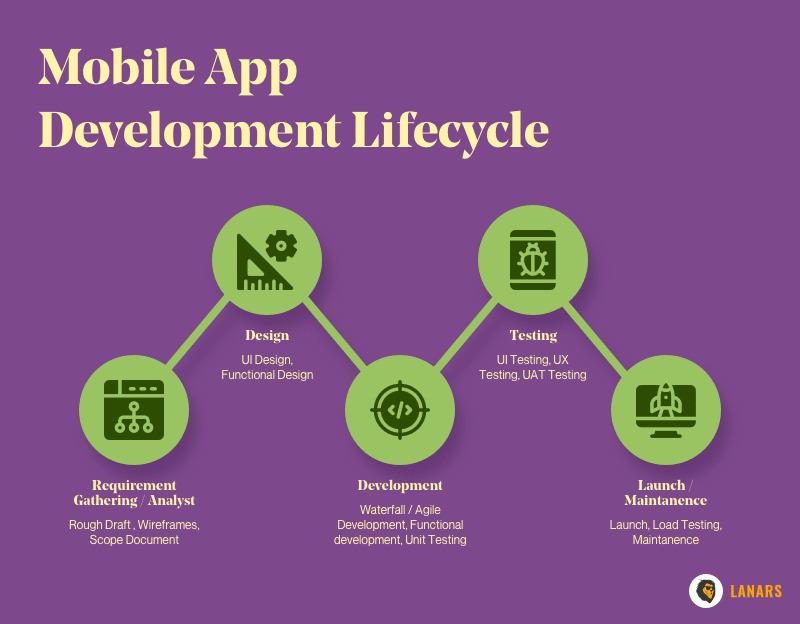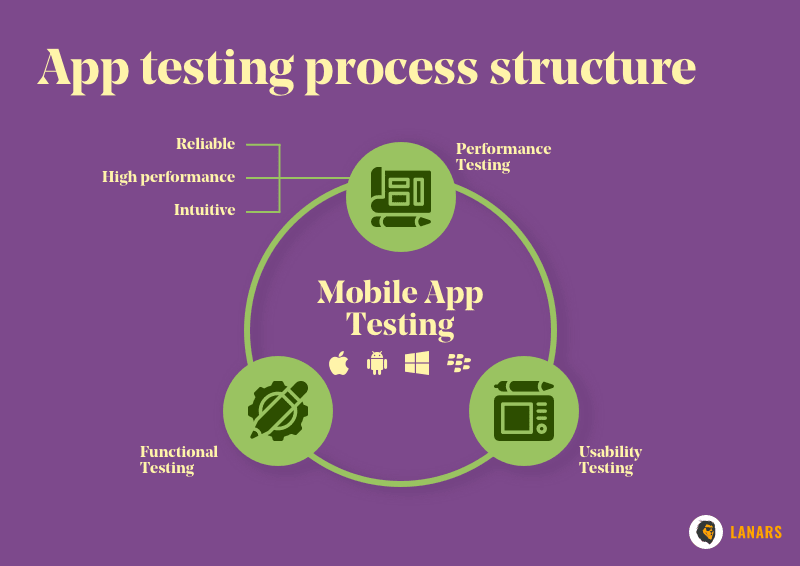By the end of 2020, the mobile app market is forecasted to generate over $189 billion globally, which makes app development one of the most profitable tech-related business fields.
Wondering if starting the process of developing an app is reasonable these days for you? Although there are 2.2 million apps available on App Store and up to 2.8 million apps are ready to be downloaded from Google Play Market, there is always a place for a new mobile app startup.
Apps like Snapchat or Tinder are examples of how an app with a good idea in the form of MVP could leave competitors behind on the overcrowded market.
But no matter how brilliant your startup idea may seem, the application development process remains tricky. Within this article, we’ll guide you across Mobile App Development Lifecycle and give some crucial hints.
Before Start Mobile App Development Process
Mobile App Development Lifecycle is based on Soft Development Lifecycle principles. It consists of several stages such as Inception (or Research), Design, Development, Stabilization, Deployment, and Maintenance.
Normally, the app development process flow starts with discovering the advantages and disadvantages of the future product idea, market research, target group study as well as project estimation.
The first thing you need to do is to transform your startup idea into a product idea.
That will help you know what kind of experts you should have in your team and how much money will be required.
The second step to develop an app within the Inception stage is polishing your app conception. Think about what benefits could bring your product to users and discover market niche where your target audience may find a similar solution (what should be your exclusive value and competitive advantage then?). Study the competitive environment and get to know if your target market area is profitable for newcomers.
Also, try to describe your target users — gender, age, occupation, position, family status, and geography. Think of their problems, fears, and needs.
Finally, take one more app development step and go deeper into app features. List key features you’d like to have in your app, specify technologies that could be used to enable the full scope of desired functions (camera integration, GPS, fingerprint scanning).
Having a tech description of the product, go to its evaluation. Decide what platform you need to build your app for (iOS, Android, or both) and evaluate your team potential to launch the app.
Choose a programming language, set project timelines, decide on monetization strategy and promotion, and come up with a PRD (product requirements document).
Learn more about the app development team from our article How to Hire a Dedicated Development Team.
Mobile Application Development Process: Workout Your Design
This stage is not only about app interfaces but also about the product user flow, data architecture, and functions. UX and UI designers, PM, data analysts, as well as developers and focus group representatives may be involved in the process.
The app design and development process could be separated into prototyping, app features and design wireframing, storyboard creation, and design itself. In the end, you’ll have a design for each of the screens of your products and documents that reflect app data and functional structure.
Keep in mind that the design stage starts with a rapidly created prototype where just the app concept could be reflected. The idea of the design phase is to transform PRD into a full-scope visually detailed document that could be understood by developers.
To avoid mistakes that may cost you a double design budget try to interact with the focus group as much as possible. Show it in a prototype and its versions, present different approaches to UX (app flow and interactions) and UI (app outlook), then get the feedback and specify tasks for your design team if needed.
Remember that design is an essential mobile app development process step because it is the core factor that influences user experience. A good idea is to create a mood board or reference board apart from standard app flow documentation before designers start their work.
App Development Cycle: Development Stage
Development is believed to be the most costly and active phase of the mobile app development cycle. You start it with tech requirements and design and finish having a ready-to-use product. Development may be separated into two stages — app prototyping and coding.
What’s the difference between prototyping on the design phase and here? Design prototype is usually about UX or UI. It could be created for focus groups or investors to present them with the key features of app appearance and choose the correct way to move on.
Here, we are speaking about tech prototyping that could be skipped if tech requirements avoid further engineering approach search.
The application development phase called coding includes front-end and back-end developments. The idea is to enable interface functions.
For this, data engineer and Android (iOS or cross-platform) developers are needed.
When the app code skeleton is ready (Alpha phase), it’s high you add features to the product, bug pretesting, and ongoing improvements (Beta phase). Your app may be also presented to your focus group to gain early feedback.
Mobile application development process could be considered as completed after all bugs have been fixed and the product is ready to be realized (Release phase).
Mind that iOS, Android and cross-platform development have different budgets! Choose your option with our article Android vs iOS: Which Platform to Build Your App for First Is Better.
Stages of App Development: App Stabilization and Deployment
As you see, development and stabilization app development stages are closely connected. The development process is usually conducted by app elements which means that QA proceeds with testing moving from one element to another. The method is called regression testing and could be automated.
App development process steps of app stabilization include general product testing (the idea is to identify app defects and delete bugs) on alpha, beta and release phases that were described in the previous article.
Gathering focus group feedback (user acceptance testing) is also a part of product stabilization as it is always less money-consuming to improve an app on early development stages having user feedback besides QA team resolution.
Mobile app development process on the app stabilization phase includes:
- Functional and security tests (if app features work as it was expected)
- Usability and design tests (if app design performs well and navigation is convenient)
- Productivity tests (if databases are stable and your app operates fast)
- Tests using target devices (if an app performs well on Android and iOS smartphones and tablets)
- Regression tests (testing of all app features on alpha and beta phases)
- User acceptance test (gathering feedback from focus group)
When tests are over, a good idea is to strengthen your app with a tool for analytics to continue with obtaining user feedback, studying their behavior and retention rate.
Improve your product unstoppably before and after release. Learn more about MVP (minimum viable product) and Build—Learn—Measure loop from our blog article How to Build a Minimum Viable Product.
Product Maintenance
The mobile application development process is not completed if you didn’t release your product to the market. Product launch is an important stage of your startup.
Soon after your app will have been uploaded to App Store and Google Play market you need to study users’ feedback, make necessary improvements and updates, provide tech support for your product, as well as fix issues on users’ requests.
What goals should be set on the deployment and maintenance phases? First, you should get as many downloads (users) of your app as it is possible. The more people you’ve got inside your app, the more information you’ll gain for further improvements.
Promotion strategy is your primary instrument. What monetization model are you going to use? How potential users will get to know about your product? Answer these questions on the discovery phase of your mobile app development process and start a promotional campaign 6 months before the app launch.
Use SEO, promotional landing pages, and advertisement. For detailed information on app monetization models read our article How you can monetize your app idea.
Product maintenance includes such types of activity:
- Planning and developing new app features
- Studying users’ feedback and analytics and making conclusions to conduct further product development
- Direct promotion and PR
- Ongoing tech support
- Uploading new content
- Serving customers (if your product provides services or users have a chance to receive direct help from your support team)
Regarding your app idea, you may need a small, medium-sized or large maintenance team. Don’t forget to think of what type of experts you’ll need to support your product on the budget planning phase (Research) and include maintenance costs to your budget.
Read How much does it cost to make an app article to estimate your project carefully.
Conclusion
Today, mobile apps are a part of our everyday life. According to global statistics, smartphone users spend up to 90% of their gadget-related time checking apps. However, the app market is generally a highly competitive environment which means that modern startupers should be extremely careful planning their project, conducting the app development process and maintaining the final product. Every mistake will cost you market position loss!
To avoid mistakes, foresee app development process steps and be prepared to make them.
Inception (Research), Design, Development, Stabilization, Deployment, and Maintenance — all of those project idea implementation phases need experts, money and time. Start with turning your startup idea into product tech requirements and concept documentation. Then, proceed with budgeting.
Be aware of your marketing too. Choose a proper monetization model. Plan and start your promotion campaign before the official release day. Remember that mobile app development process steps are just the very beginning of your project story. To compete in the current mobile app market, your product must be flexible and frequently updated.
Follow user feedback and their behavior and never stop trying to make the product cooler!







Top comments (3)
This is an outstanding breakdown of the entire journey of mobile app development! It's wonderful to see planning, prototyping, and iterative testing as the keys to its success. The post-launch maintenance section is also something very valuable, since not many people consider it yet it's crucial for the long run of an app. In essence, this guide gives out a very solid framework in developing and sustaining a mobile app.
This article on Mobile App Development is incredibly insightful! I love how you break down complex topics like UX/UI design in such a clear and engaging way. Your passion for creating user-friendly apps truly stands out.
On that note, Innoit Labs is a highly regarded mobile app development company known for its expertise and user-centered approach. If you're looking for a trusted development partner, they’re definitely worth checking out.
Thanks for the fantastic content—I look forward to reading more!
Some comments may only be visible to logged-in visitors. Sign in to view all comments.